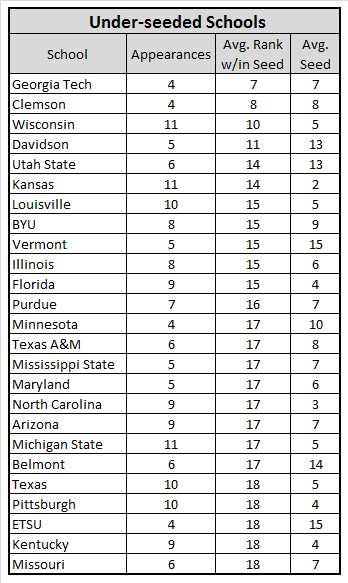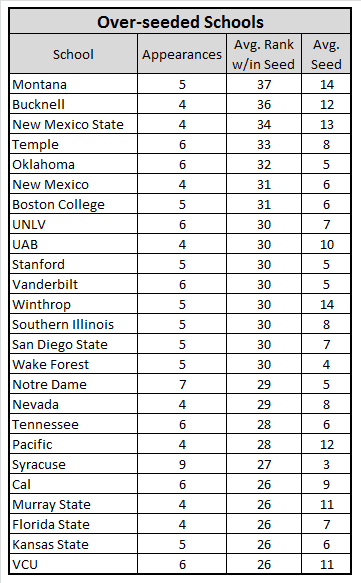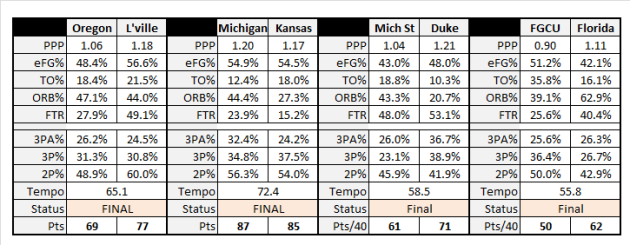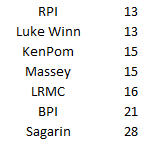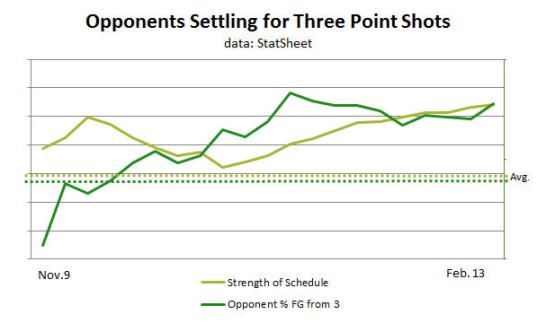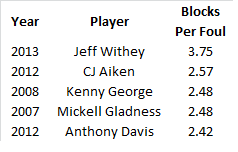2013-2014 College Basketball Top 25 Preseason Rankings
May 27, 2013 Leave a comment
Below are my preseason college basketball rankings for the 2013-2014 season. I’ve tried to include a breakdown of what each team lost, gained and kept in terms of personnel.
These rankings are based on the following statistical data, combined with some personal adjustments: (1) performance loss from graduates, transfers, and NBA/NBADL draftees; (2) performance gained from transfers, recruits,etc.; (3) previous season performance.
1. LOUISVILLE
Lost: Peyton Siva, Gorgui Dieng
Returning: Russ Smith, Chane Behanan, Luke Hancock, Wayne Blackshear, Montrezl Harrell, Kevin Ware, Stephan Van Treese
New: Chris Jones, Anton Gill, Terry Rozier, Akoy Agau, Mangok Mathiang
2. MICHIGAN STATE
Lost: Derrick Nix
Returning: Keith Appling, Gary Harris, Adreian Payne, Branden Dawson, Denzel Valentine, Travis Trice, Russell Byrd, Matt Costello, Kenny Kaminski
New: Gavin Schilling, Alvin Ellis
3. KENTUCKY
Lost: Nerlens Noel, Archie Goodwin, Julius Mays, Ryan Harrow
Returning: Willie Cauley-Stein, Alex Poythress, Kyle Wiltjer
New: Julius Randle, Dakari Johnson, Aaron Harrison, Andrew Harrison, James Young, Marcus Lee, Derek Willis
4. DUKE
Lost: Mason Plumlee, Seth Curry, Ryan Kelly
Returning: Rasheed Sulaimon, Quinn Cook, Amile Jefferson, Josh Hairston, Alex Murphy, Tyler Thornton, Andre Dawkins
New: Rodney Hood (Mississippi State), Jabari Parker, Semi Ojeleye, Matt Jones
5. OHIO STATE

Lost: Deshaun Thomas, Evan Ravenel
Returning: Aaron Craft, Lenzelle Smith, LaQuinton Ross, Sam Thompson (#12 in video), Shannon Scott, Amir Williams
New: Kameron Williams, Marc Loving
6. MICHIGAN
Lost: Trey Burke, Tim Hardaway Jr.
Returning: Glenn Robinson III, Mitch McGary, Nik Stauskas, Jordan Morgan, Jon Horford, Spike Albrecht, Caris LeVert
New: Derrick Walton, Zak Irvin, Mark Donnal
7. OKLAHOMA STATE
Lost: Philip Jurick
Returning: Marcus Smart, Le’Bryan Nash, Markel Brown, Brian Williams, Phil Forte, Michael Cobbins, Kamari Murphy
New: Stevie Clark, Detrick Mostella, Leyton Hammonds, Gary Gaskins, Jeffrey Carroll
8. NORTH CAROLINA
Lost: Dexter Strickland, Reggie Bullock
Returning: P.J. Hairston, James Michael McAdoo, Marcus Paige, Brice Johnson, J.P. Tokoto, Joel James, Desmond Hubert, Leslie McDonald
New: Kennedy Meeks, Nate Britt, Isaiah Hicks
9. ARIZONA
Lost: Mark Lyons, Solomon Hill, Kevin Parrom, Grant Jerrett, Angelo Chol
Returning: Nick Johnson, Brandon Ashley, Kaleb Tarczewski, Jordin Mayes, Gabe York
New: T.J. McConnell (Duquesne), Aaron Gordon, Rondae Jefferson, Elliott Pitts
10. KANSAS
Lost: Ben McLemore, Jeff Withey, Elijah Johnson, Travis Releford, Kevin Young
Returning: Perry Ellis, Naadir Tharpe, Jamari Taylor
New: Andrew Wiggins, Wayne Selden, Joel Embiid, Conner Frankamp, Brannen Greene, Frank Mason
11. SYRACUSE
Lost: Michael Carter-Williams, James Southerland, Brandon Triche
Returning: C.J. Fair, Rakeem Christmas, DaJuan Coleman, Jerami Grant, Baye Moussa Keita, Trevor Cooney
New: Michael Gbinije (Duke), Tyler Ennis, B.J. Johnson, Tyler Roberson, Ron Patterson, Chinonso Obokoh
12. FLORIDA
Lost: Mike Rosario, Erik Murphy, Kenny Boynton
Returning: Patric Young, Scottie Wilbekin, Casey Prather, Michael Frazier, Will Yeguette
New: Chris Walker, Kasey Hill, Damontre Harris (South Carolina), Dorian Finney-Smith (Virginia Tech)
13. VCU
Lost: Troy Daniels, Darius Theus
Returning: Treveon Graham, Juvonte Reddic, Rob Brandenberg, Melvin Johnson, Briante Weber, Jordan Burgess
New: Terrance Shannon (Florida State), Antravious Simmons, Jairus Lyles, JeQuan Lewis, Doug Brooks
14. WISCONSIN
Lost: Jared Berggren, Ryan Evans, Mike Bruesewitz
Returning: Josh Gasser, Ben Brust, Sam Dekker, Traevon Jackson, Frank Kaminsky, George Marshall, Zak Showalter
New: Bronson Koenig, Nigel Hayes, Vitto Brown, Riley Dearring, Jordan Hill
15. MEMPHIS
Lost: D.J. Stephens, Adonis Thomas, Tarik Black, Antonio Barton, Ferrakohn Hall, Stan Simpson
Returning: Joe Jackson, Chris Crawford, Geron Johnson, Shaq Goodwin
New: David Pellom, Austin Nichols, Nick King, Kuran Iverson, Markel Crawford, Pookie Powell
16. VIRGINIA
Lost: Jontel Evans
Returning: Joe Harris, Akil Mitchell, Justin Anderson, Mike Tobey, Evan Nolte, Darion Atkins, Teven Jones, Taylor Barnette
New: London Perrantes, Devon Hall
17. INDIANA
Lost: Cody Zeller, Victor Oladipo, Christian Watford, Jordan Hulls, Remy Abell, Maurice Creek
Returning: Will Sheehey, Yogi Ferrell, Jeremy Hollowell, Hanner Mosquera-Perea, Peter Jurkin
New: Noah Vonleh, Troy Williams, Stan Robinson, Luke Fischer, Devin Davis, Collin Hartman
18. GONZAGA
Lost: Kelly Olynyk, Elias Harris, Guy Landri Edi, Mike Hart
Returning: Kevin Pangos, Gary Bell Jr, Sam Dower, Przemek Karnowski, David Stockton, Drew Barham, Kyle Dranginis
New: Ryan Edward, Lucas Meikle, Gerard Coleman (Providence), Angel Nunez (Louisville)
19. UCLA
Lost: Shabazz Muhammad, Larry Drew III
Returning: Jordan Adams, Kyle Anderson, Travis Wear, David Wear, Norman Powell, Tony Parker
New: STEVE ALFORD (coach), Bryce Alford, Zach LaVine, Noah Allen
20. MARQUETTE
Lost: Vander Blue, Junior Cadougan, Trent Lockett
Returning: Davante Gardner, Jamil Wilson, Chris Otule, Todd Mayo, Steve Taylor, Derrick Wilson
New: Jajuan Johnson, Jameel McKay, Duane Wilson, Deonte Burton, John Dawson
21. SAINT LOUIS
Lost: Cody Ellis, Kwamain Mitchell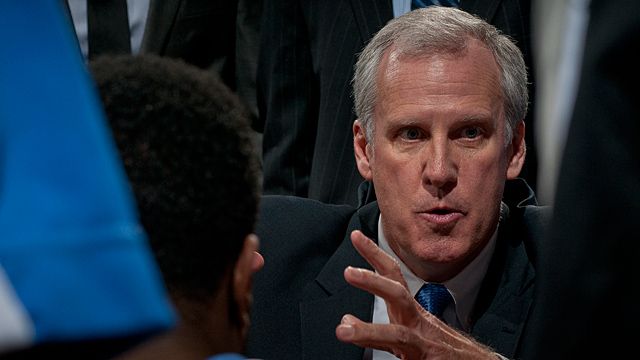
Returning: Dwayne Evans, Jordair Jett, Mike McCall, Rob Loe, Cory Remekun, Grandy Glaze, John Manning, Jake Barnett
New: Austin McBroom (Central Mich), Tanner Lancona, Mike Crawford, Reggie Agbeko
22. COLORADO
Lost: Andre Roberson, Sabatino Chen
Returning: Spencer Dinwiddie, Askia Booker, Josh Scott, Xavier Johnson
New: Tre’shaun Fletcher, Dustin Thomas, Jaron Hopkins, Wesley Gordon, Chris Jenkins
23. ALABAMA
Lost: Andrew Steele, Moussa Gueye, Trevor Lacey
Returning: Trevor Releford, Rodney Cooper, Nick Jacobs, Levi Randolph, Retin Obasohan, Devonta Pollard
New: Jimmie Taylor, Shannon Hale, Algie Key
24. WICHITA STATE
Lost: Carl Hall, Malcolm Armstead, Ehimen Orukpe
Returning: Cleanthony Early, Ron Baker, Fred an Vleet, Nick Wiggins, Evan Wessel, Tekele Cotton, Chadrack Lufile,
New: D.J. Bowles, Ria’n Holland
25. GEORGETOWN
Lost: Otto Porter
Returning: Markel Starks, D’Vauntes Smith-Rivera, Nate Lubick, Jabril Trawick, Mikael Hopkins, Greg Whittington, Aaron Bowen, Moses Ayegba
New: Josh Smith (UCLA – possible to play 2nd semester), Reggie Cameron
OTHERS CONSIDERED: Villanova, Harvard, Notre Dame, Boise State, Tennessee, Connecticut
